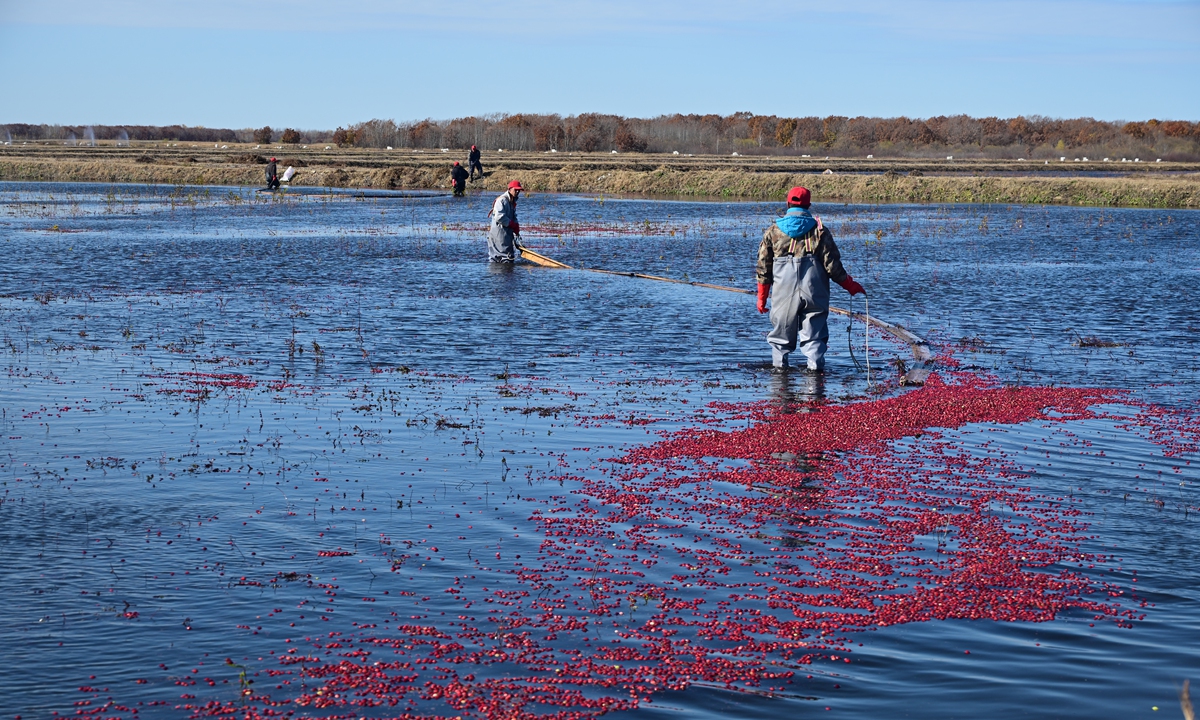Cities in NE China nurture new businesses, banking on geographic locations and unified national market
New business models ignite growth vitality in Northeast China

Farmers harvest cranberries within a flooded field in Fuyuan, Northeast China's Heilongjiang Province on October 12, 2024. Photo: Tao Mingyang/GT
Editor's Note:
As the Chinese economy, along with the global economy, faces challenges, some Western politicians and media outlets have intensified their smear campaigns against the world's second-largest economy. They cherry-pick information and distort facts to promote their narratives like "Peak China," while ignoring China's economic resilience and growth potential. To set the record straight, the Global Times is launching a multimedia project featuring in-depth articles, objective analyses, and visual arts to present a comprehensive and accurate picture of the Chinese economy. This is the 15th installment of the series.
In mid-October every year, in Heihe, Northeast China's Heilongjiang Province, the last batch of tourists who have come for a taste of the autumn's glamour are hurried off by a fast drop in temperatures.
The temperatures in the city begin to fall drastically as days go by, eventually dropping to -40 C in winter, ordinary people may think that the city, one of the northernmost cities in China, is about to start a new round of hibernation. On the contrary, the city's roads begin to welcome a growing motorcade of vehicles strangely painted in zebra stripes.
These vehicles, sent here for performance tests by some of the world's largest automotive companies, will rule the city's streets and surrounding testing ground in the winter.
Citizens of Heihe are no strangers to them. In their city, the lively winter months, which can last up to five months, are about to begin.
Car-testing parks
Diao Weidong, an official from the Heihe city government, told the Global Times that in recent years, the city has continued to develop its winter vehicle testing industry, which has now emerged as one of the largest in the country and has become an innovative business model, injecting fresh momentum to Heihe's growth.
Diao said that the business of accommodating cars conducting tests under harsh winter conditions dates back to the 1970s, but the city has been consciously developing this new sector ever since 2006.
By 2020, a total of 24 brand-owned winter car testing grounds were set up in the city and its surrounding areas, accommodating leading automakers and automotive parts manufacturers who prioritize confidentiality over costs, both from home and abroad.
Analysts said that some cities in China can take advantage of the unified national market and give full play to their unique geographical and climate resources have become one of the conspicuous advantages of China's economic development.
Song Kui, a senior expert based in Harbin, Heilongjiang, told the Global Times that the local government's efforts in seeking and nurturing fast-growing business models fit well into the historical mission to strive to achieve the full revitalization of Northeast China.
In Heihe, the business banked on China's fast-growing automobile industries. Because Chinese automakers are rolling out new models at a pace unprecedented in global automotive history, continuous tests are necessary before vehicles are market-ready.
"Before, automakers take around 3.5 years to bring a new model to market, but now, they do it in 1 to 1.5 years, so the demand is huge," Diao said. "However, it must be noted that nature's endowments require sustained government support for the industry to gain traction."
Over the years, the city government has worked strenuously to meet the increasing demand for car testing companies to pave the way for the industry's growth.
"We have pushed through a regulatory labyrinth to make it available for car testing companies to test their vehicles on the nearby expressways and opened up all the roads in the city proper for tests," Diao said.
He added that 5G wireless towers were erected and optical fiber cables laid down to allow new-generation intelligent connected vehicles to conduct tests, and "we also built a solar power plant to help related testing facilities slash electricity costs."
Supportive businesses of various kinds, from building roads to erecting charging poles to car repair shops thrived. "Usually, in one testing season, the city's tire shops can sell thousands of tires," Diao noted.
Cranberry farms
A similar story regarding the utilization of "coldness" resources also unfolded in Fuyuan, the easternmost city in the Chinese mainland.
Local farmers here have spent the past decade introducing North American cranberries into China and cultivating Asia's largest cranberry growing areas, measuring 280 hectares, by introducing and digesting foreign agricultural technologies and adapting to local conditions.
Li Feng, general manager of Fuyuan-based Red Sea Farm, told the Global Times that the plantation of cranberry, which originated from North America, requires a cold and damp environment.
Fuyuan, located at a high latitude amid grand rivers and lakes, is the most perfect spot to grow cranberries among several potential locations his company had in mind.
"But growing cranberry in China has not been an easy ride and we only achieved what we have today after receiving solid support from the local government," Li said.
Li said since 2018, agricultural technicians at the Institute of Natural Resources and Ecology of Heilongjiang Academy of Sciences have been lending their assistance and guidance to help farmers improve cranberry yield and fruit quality and fend off weeds and pests.
Additionally, Li noted that his farm's success also relies on China's manufacturing capabilities.
"For instance, the harvesting machines we purchased from abroad cannot work well in the local condition, as it proved too harsh on the crop, so we developed machines better suited to our conditions with the help of many factories in China," Li said. "To be inside the World's Factory means you are at an advantage in choosing suppliers and quickly ironing out problems."
Cranberry output only went up after mechanized harvesting was applied. In 2023, Li's farm yielded 2,700 tons of fresh cranberries, with an economic value of 70 million yuan ($9.8 million).
To help cultivate cranberry seeds and raise proprietary cranberry breeds, the local and provincial governments also helped Li's company send 100,000 cranberry seeds onboard China's Shenzhou spaceship for space-environment cultivation in 2022 and 2023, Li said.
According to the Xinhua News Agency, the Fuyuan city government is betting on nurturing cranberries with homegrown seeds and developing a string of related businesses including cranberry breweries, fruit juice, cosmetics, and agriculture tourism.
Given cranberries' health benefits, Li noted that market demand far exceeds his farm's output, adding a high-growth sector to the fertile plains of Northeast China.
The income generated from one acre of cranberry fields equals that of 50 acres of rice and 100 acres of soybeans, Li told the Global Times, adding that crop of this year has been sold out one month earlier than planned and his company is contemplating plans to expand growing areas by nearly eightfold.




